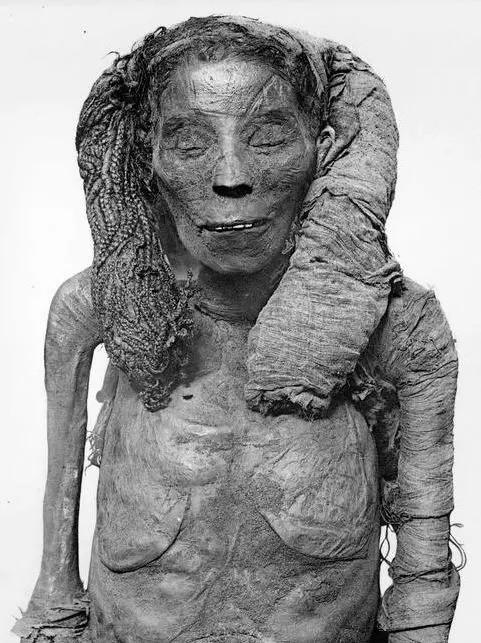A Royal Nursemaid’s Journey Through Time
In 1881, during excavations at Deir el-Bahari, near Luxor, archaeologists uncovered a burial that would become one of the most fascinating discoveries in Egyptian archaeology — the mummy of Lady Rai, a royal nursemaid who served Queen Ahmose-Nefertari, one of ancient Egypt’s most revered queens. Dating back to around 1530 BCE, Lady Rai’s burial offers an extraordinary window into life, death, and medical knowledge in the early 18th Dynasty, a period that marked the dawn of Egypt’s New Kingdom and its golden age of prosperity.
The Mummy That Defied Time

Lady Rai’s remains astonished early Egyptologists not just for their antiquity but for their exceptional preservation. Standing at only 4 feet 11 inches (1.5 meters) tall, she was likely between 30 and 40 years old at the time of her death. Yet even after 3,500 years, her features remained strikingly intact. Her skin, facial structure, and even her hair — still neatly braided — survived the millennia, allowing researchers to study her as if she had only recently passed.
“The preservation of Lady Rai is so remarkable that she could be mistaken for someone mummified only a few centuries ago,” noted one museum curator at the Egyptian Museum in Cairo, where her mummy now resides.
Her carefully wrapped linen bandages and elaborate preparation reflected her high social rank and the sophistication of early New Kingdom embalming techniques. Her burial chamber contained fine jewelry, pottery, and cosmetics, all symbolic offerings intended to accompany her into the afterlife — testament to the Egyptian belief that death was merely a continuation of life in another realm.
Secrets Revealed by Modern Science

In 2009, modern technology breathed new life into Lady Rai’s story. A CT scan conducted by the Hawass Mummy Project, led by Dr. Zahi Hawass, revealed astonishing findings: Lady Rai suffered from atherosclerosis, a condition characterized by the hardening of the arteries. This made her the oldest known case of cardiovascular disease ever documented in human history.
The discovery challenged long-held assumptions that heart disease was a modern condition caused by contemporary lifestyles. Instead, it suggested that ancient Egyptians, even those of elite status, were susceptible to similar health issues — possibly due to diets rich in fatty meats and sedentary living.
“The scan proved that heart disease is not just a modern affliction,” explained Dr. Hawass. “It’s part of our biological legacy, stretching back thousands of years.”
Lady Rai’s case added a crucial chapter to the ongoing Global Mummy Project, which studies ancient remains to better understand the evolution of human health and disease.
A Glimpse into Life and Death in Ancient Egypt

Lady Rai’s burial provides a rare look at the rituals and social customs of early 18th Dynasty Egypt. As a nursemaid to Queen Ahmose-Nefertari — wife of Pharaoh Ahmose I and mother of Amenhotep I — she occupied a privileged but intimate position within the royal household. Her role as caretaker to the royal children placed her among the trusted members of the court, granting her a tomb and mummification treatment typically reserved for nobles.
Inside her tomb, archaeologists found amulets, cosmetic vessels, and personal ornaments, each carrying symbolic meaning. These items not only reflected her status but also mirrored Egypt’s deeply spiritual culture — one where the dead were equipped with both beauty and protection for eternity.
Mastery of Mummification

Lady Rai’s mummy also provides vital evidence of the evolution of mummification techniques. Her internal organs had been removed, the body treated with resins and oils, and carefully wrapped in layers of linen. Some of the bandages were inscribed with her name — a detail that helped confirm her identity.
The most captivating aspect of her preservation, however, is her hair. Still visible in tightly woven braids, it demonstrates the artistry and attention to detail characteristic of Egyptian burial preparation. For modern scholars, these preserved hairstyles reveal not only personal aesthetics but also clues to social class and cultural expression in the 16th century BCE.
Lady Rai’s Legacy

Today, Lady Rai rests in the Egyptian Museum in Cairo, where she continues to fascinate visitors and researchers alike. Her mummy serves as a poignant reminder that ancient Egypt was not merely a land of monumental architecture and gods, but also of individual lives — mothers, caretakers, and women of service — whose devotion shaped dynasties.
Her preservation bridges the gap between antiquity and modern science, showing how technology can illuminate stories long sealed by time. Through her remains, Lady Rai continues to educate us — about ancient medicine, societal roles, and the enduring quest for immortality that defined Egyptian civilization.
More than three millennia after her burial, Lady Rai stands as both a scientific marvel and a symbol of humanity’s enduring connection to its past. Her face, serene and timeless, reminds us that even across 3,500 years, the people of ancient Egypt were not so different from us — living, loving, and leaving behind traces of their world in hopes of being remembered.
